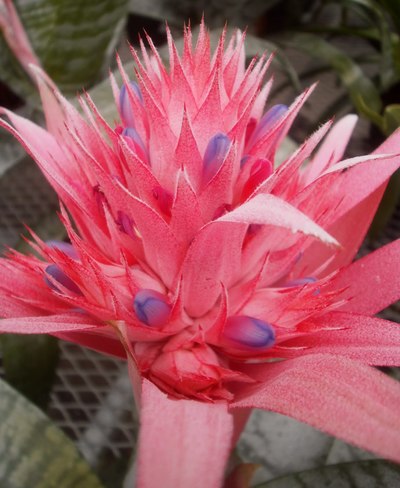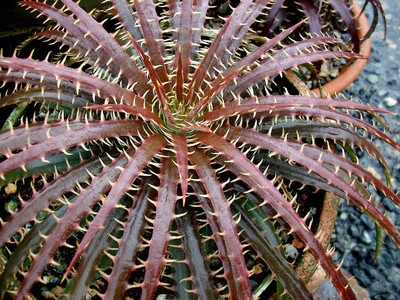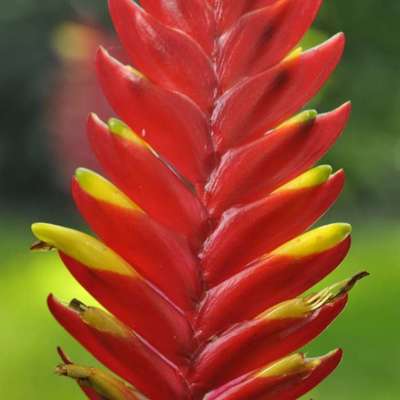|
All bromeliads are composed of a spiral arrangement of leaves sometimes called a "rosette". The number of degrees between successive leaves varies from species to species with a few having a 180 degree separation between leaves. This causes the plant to grow in a flattened configuration with its leaves lined up in a single plane. The bases of the leaves in the rosette may overlap tightly to form a water reservoir. This central cup also collects whatever leaf litter and insects happen to land in it. The more ancestral terrestrial bromeliads do not have this water storage capability and rely primarily on their roots for water and nutrient absorption. Tank bromeliads (as the water storing species are often called) rely less heavily on their roots for nourishment and are more often found as epiphytes. The roots of epiphytic species harden off after growing to form holdfasts as strong as wire that help attach the plant to its host. Even though bromeliads are commonly called parasitos in Spanish-speaking countries, these epiphytes do not take sustenance from their host but merely use it for support. In some species, the bases of the leaves form small chambers as they overlap and these protected spaces are often home to ants. In exchange for shelter, the ants' waste may provide the bromeliad with extra fertilizer.
All bromeliads share a common characteristic: tiny scales on their leaves called trichomes. These scales serve as a very efficient absorption system. In species found in desert regions where the air is hot and dry and the sun beats down relentlessly, these scales also help the plant to reduce water loss and shield the plants from the solar radiation. These plants are so covered with scales that they appear silvery-white and feel fuzzy. On many species (especially in more humid areas), the scales are smaller and less noticeable. Sometimes the scales can form patterns and banding on the leaves that add to the plant's beauty. With few exceptions, the flower stalk is produced from the center of the rosette. The stalk (or scape as it is called), may be long with the flowers held far away from the plant (either erect or hanging pendantly) or the scape may be short with the flowers nestled in the rosette. The scape may produce a single flower or many individual flowers and may have colorful leaf-like appendages called scape bracts that serve to attract pollinators and delight bromeliad enthusiasts. With rare exceptions, bromeliads only flower a single time - once the plant stops producing leaves and produces its flower, it will not start making leaves again. It will, however, vegetatively produce new plantlets called "offsets" or "pups". These plants will feed off the "mother" plant until they are large enough to set roots of their own and survive as a separate plant. The mother may sometimes survive a generation or two before finally dying off. Pups are usually produced near the base of the plant - inside the sheath of a leaf. Sometimes, however, pups may be produced on long stolons or atop the inflorescence (flower spike) of the mother plant. The green, leafy top of a pineapple is in fact a pup that may be removed and planted to start a new plant. Comments are closed.
|
AuthorSome articles courtesy of Bromeliad Society International – adapted for the San Diego region ArchivesCategories
All
|
- Home
- Join us! Membership
-
Meetings/Events
- Past: July 2024
- Past: May in the Garden
- Past: April 2024
- Past: February 2024
- Past: January 2024
- Past: December 2023
- Past: Nov. 2023
- Past: Oct. 2023
- Past: Sept. 2023
- Past: July 2023
- Past: May Tour
- Past: June 10-11 Show & Sale
- Past: April 2023
- Past: March 2023
- Past: February 2023
- Past: January 2023
- Past: Oct. 2022
- Past: Sept. 2022
- June Show & Sale Balboa Park
- Past: May 2022
- World Brom Conference 2022
- Past: April 2022
- Past: March 2022
- Past: Feb 2022
- Past: Dec. 2021 Plant Sale
- Past: Dec 2021
- Past: Nov 2021
- Past: Expo at SD Botanic Garden
- Past: August 2021
- Past: July 2021
- Past June 2021
- Past: May 2021
- Past: April '21
- past: March '21
- past: February '21
- past: January '21
- Past: December
- Past: October
- Past: September
- Past: November
- August Coffee in the Brom Garden
- Past Newsletters
- Videos
- About Us/Past Events
- Bromeliad Genera
- Links
- Growing Tips
Photo from STC4blues
- Home
- Join us! Membership
-
Meetings/Events
- Past: July 2024
- Past: May in the Garden
- Past: April 2024
- Past: February 2024
- Past: January 2024
- Past: December 2023
- Past: Nov. 2023
- Past: Oct. 2023
- Past: Sept. 2023
- Past: July 2023
- Past: May Tour
- Past: June 10-11 Show & Sale
- Past: April 2023
- Past: March 2023
- Past: February 2023
- Past: January 2023
- Past: Oct. 2022
- Past: Sept. 2022
- June Show & Sale Balboa Park
- Past: May 2022
- World Brom Conference 2022
- Past: April 2022
- Past: March 2022
- Past: Feb 2022
- Past: Dec. 2021 Plant Sale
- Past: Dec 2021
- Past: Nov 2021
- Past: Expo at SD Botanic Garden
- Past: August 2021
- Past: July 2021
- Past June 2021
- Past: May 2021
- Past: April '21
- past: March '21
- past: February '21
- past: January '21
- Past: December
- Past: October
- Past: September
- Past: November
- August Coffee in the Brom Garden
- Past Newsletters
- Videos
- About Us/Past Events
- Bromeliad Genera
- Links
- Growing Tips



